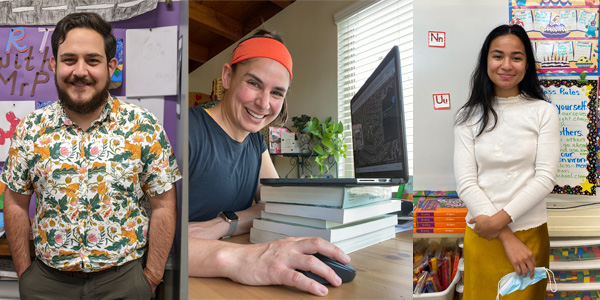 |
| From left: Credential students Jake Palacio, Valerie Salgado and Tasha Irianto. |
Tasha Irianto says it’s the little moments she’s missed the most. Because of the COVID-19 pandemic, the San Diego State University teaching credential student went months without seeing her second graders outside of a Zoom window.
“I feel like everything online is so structured,” said Irianto, who is completing her student teaching at San Diego’s Oak Park Elementary. “We don't get any of that natural classroom interaction where the kids are telling me about their weekend while putting their backpacks on.”
For Irianto and hundreds of SDSU’s future educators, those small yet meaningful connections are coming back.
San Diego Unified School District returned to in-person instruction on April 12, with other districts in San Diego County opening their doors later this month. That means it’s also back to school for many of the more than 600 SDSU students who are working towards their elementary (multiple subject), secondary (single subject), special education or bilingual teaching credentials.
The requirements student teachers face to get back into the classroom vary by school site and district. To ease the transition, SDSU’s College of Education provided students verification of eligibility to be vaccinated within Tier 1B as well as a two-page safety protocol for guidance.
Special education credential student Valerie Salgado — a student teacher in a class for students with moderate to severe disabilities at Rancho Elementary in the La Mesa-Spring Valley School District — embraced her return on April 20.
“I think to choose this profession, you have to be someone who embraces chaos,” she said. “You have to think creatively and take on big challenges. So my peers have seemed very cool, calm and collected about this whole situation.”
Returning safely
Jake Palacio, a multiple subject credential student who is completing his student teaching at Bancroft Elementary in the La Mesa-Spring Valley School District, has an idea of what’s in store for his classmates.
Upon starting the program last fall, Palacio was paired with a guide teacher who volunteered to model how a return to in-person learning would work. For the better part of a year, Palacio has been in the classroom with a dozen sixth graders while another 20 Zoom in virtually. On April 20, all but four returned in-person.
“Bancroft has done an excellent job of making things really safe,” he said. “When I found out at the start of the year that it was my guide teacher who was going to do this, I was pretty hesitant if I'm being honest. But everyone involved has been so professional and so careful. I feel great about being here.”
That’s not to say the return to in-person learning has been without its challenges. How do you, for instance, teach a group of pre-teens physical education without them coming into contact with each other or sharing a ball? How do you break students up into small groups while maintaining physical distancing?
“We've often expanded ourselves outside the classroom to picnic tables so one group can physically remove themselves from the space,” Palacio said.
Embracing challenges
Irianto said she was unsure how her Oak Park students would react to the transition back into the classroom. As a virtual instructor, her day consisted of three hours of synchronous online instruction followed by two hours of asynchronous tutoring. She’s now with her kids from 9 a.m. to 3:30 p.m., four days per week.
“It's been such a long time since they've been in that environment, I don't know how it's going to go,” she said. “But I think one thing that my guide teacher and I talk about is being flexible and taking it day by day. So I'm nervous, but I'm just really excited to see them and to be in person with them.”
Salgado is eager to see how in-person instruction amid the pandemic will play out in her class — special education, after all, is often a hands-on job.
“Especially with kids who struggle to process auditory information or kids who have limited verbal communication, a lot of times you have to physically prompt them to do the things that you want them to do,” she said. “Obviously we want to abide by all the rules that are set up, but it's going to be very challenging to do that when physical touch is a big part of the teaching and learning process with our students.”
Consider it just another transition in a year of training that has presented unprecedented challenges.
But as they prepare to enter a profession that demands flexibility, problem solving and quick thinking, SDSU’s future teachers have more than proved their mettle.
“We’ve had to be so nimble and accepting of change because from day to day or week to week, things change,” Palacio said. “There can be new regulations or new guidelines. And we’ve gained so much experience in educational technologies and online resources. I think more technology is going to come into the classroom, so to get experience with all of those tools in such an intensive way has really been valuable.”
Added Salgado: “I think we’re ready to meet the challenge of stepping into the profession next year — even under the circumstances that we've had.”
